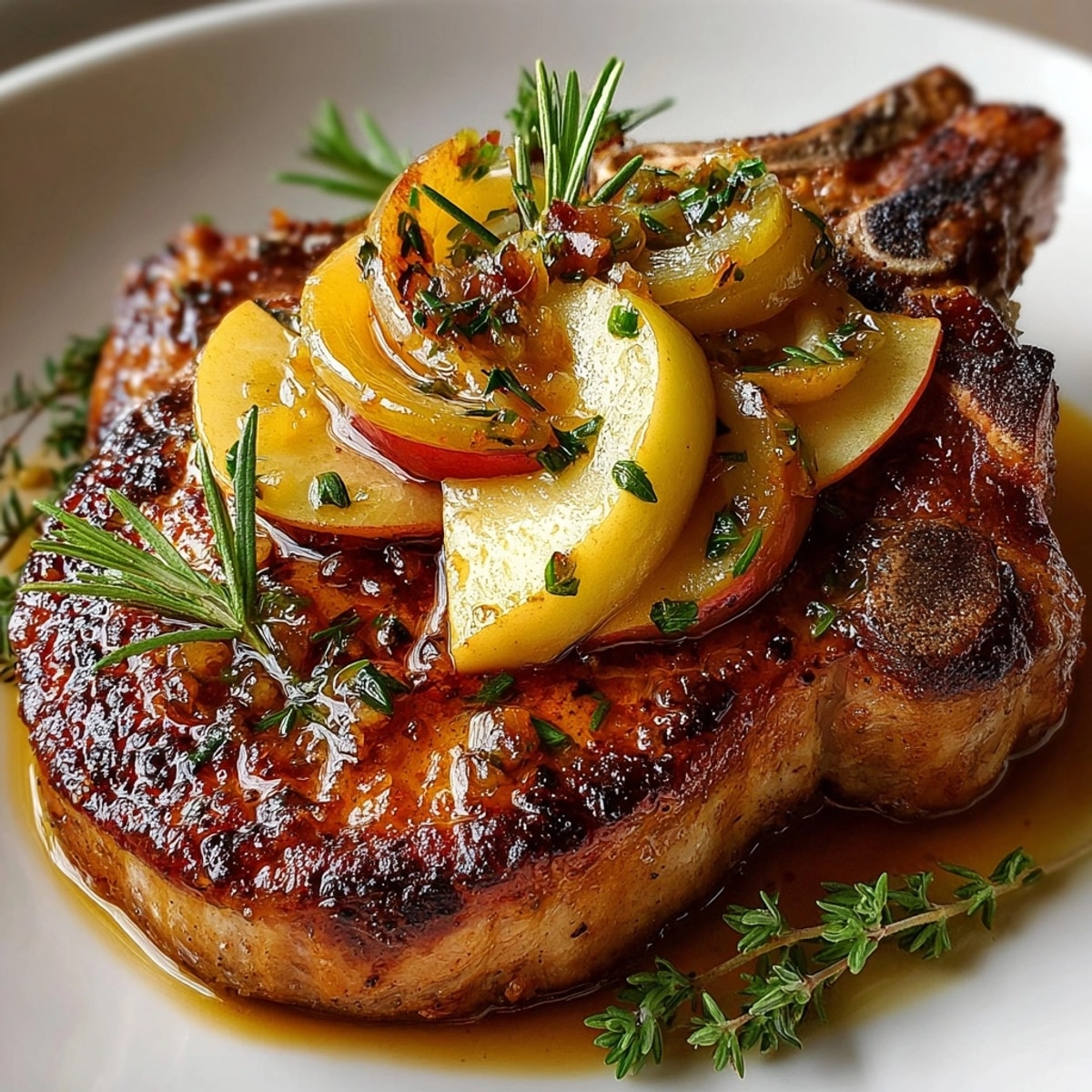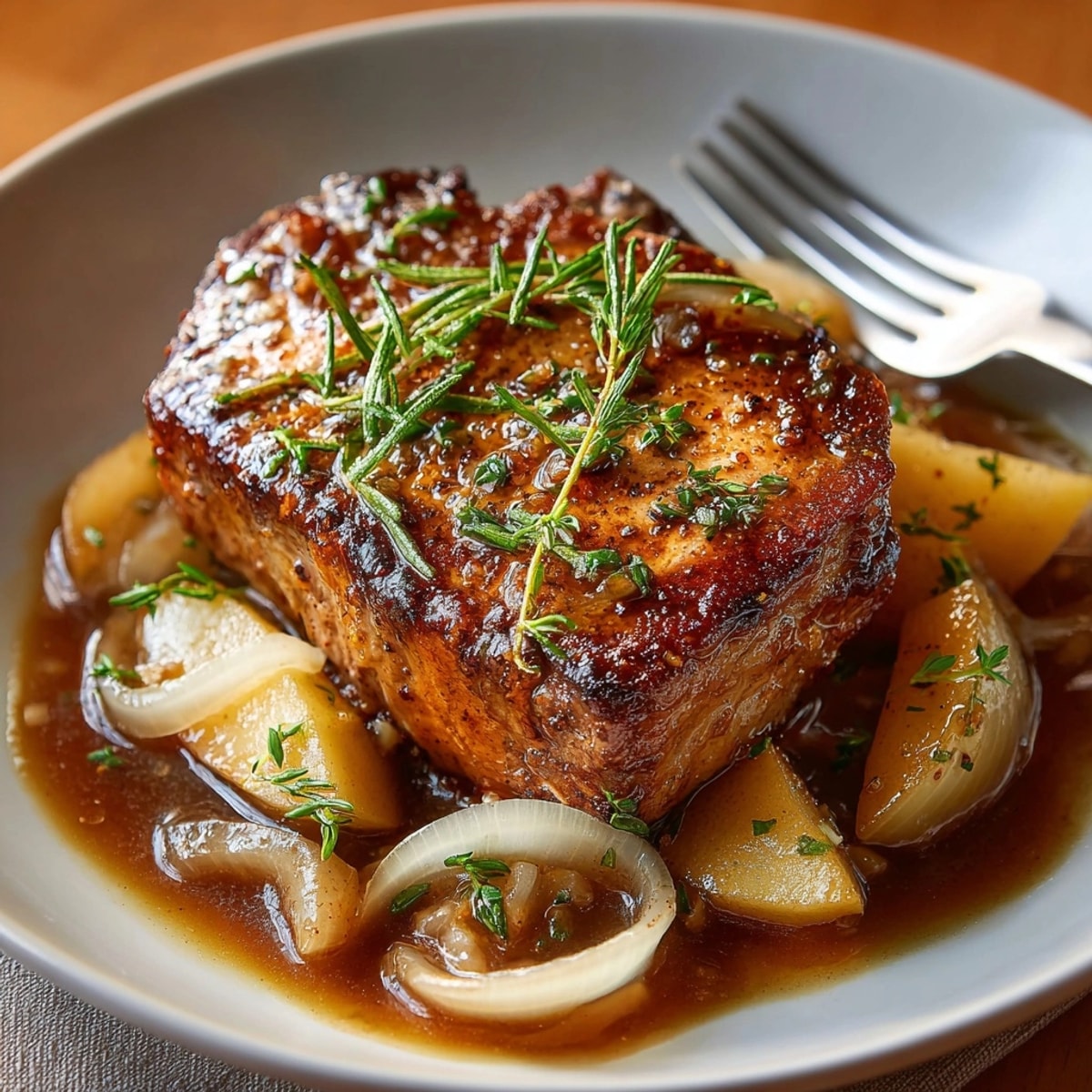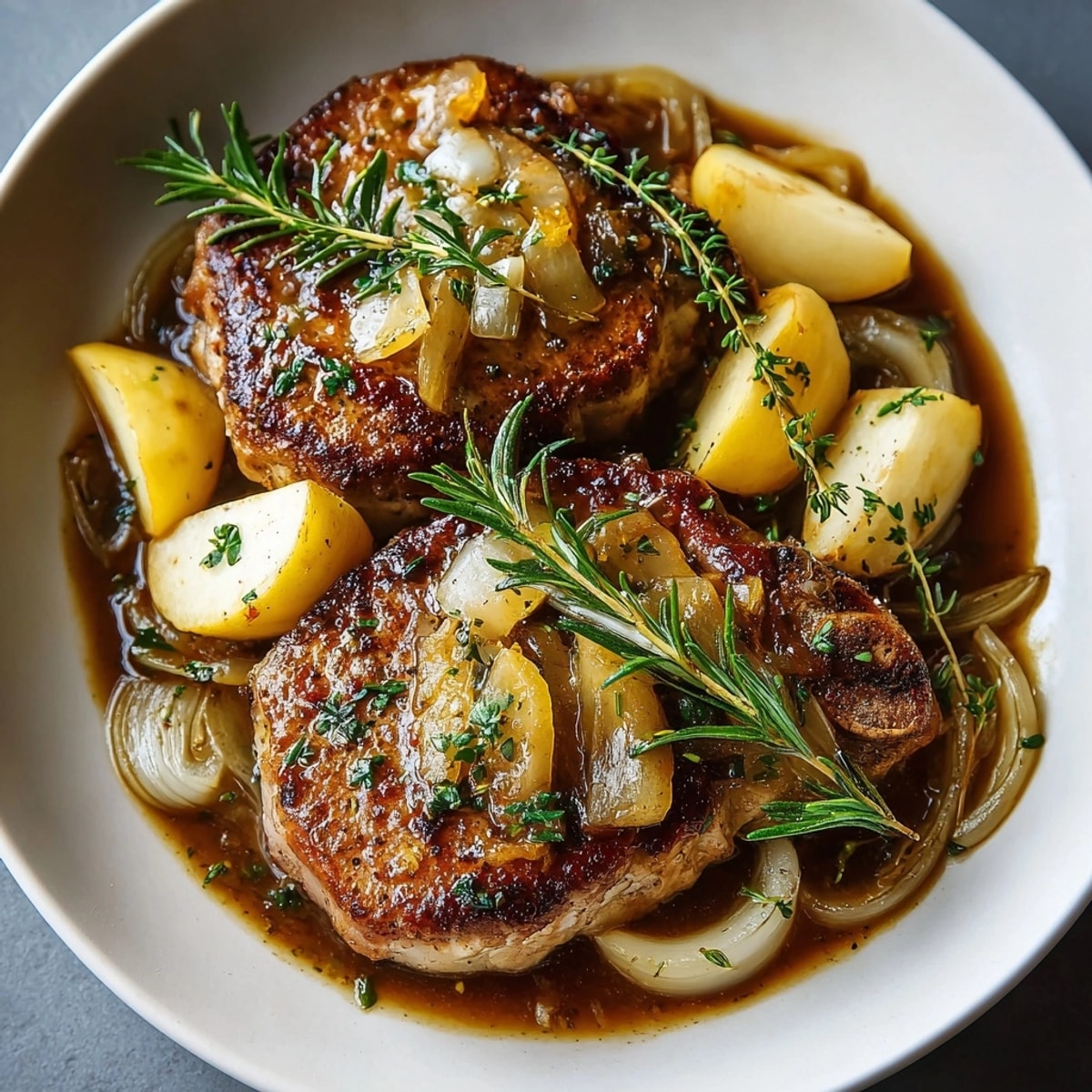 Pin
Pin This tender pork chops braised in crisp apple cider with onions, apples, and aromatic herbs has been my go-to comfort food for cozy evenings, bringing the warmth of fall right to the table every time we make it.
I first discovered a version of this recipe on a crisp autumn weekend, experimenting with local apple cider from the farmers market. Now, it's the dish my family begs for whenever the leaves start changing, and they've even started helping me slice the apples.
Ingredients
- bone-in pork chops about 1 inch thick around 200 g each: bone-in adds extra flavor during braising; pick ones with a bit of marbling for tenderness and ensure they're fresh with no off smells.
- medium apples cored and sliced: go for firm varieties like Honeycrisp or Granny Smith to balance sweetness and tartness; organic if possible to avoid wax coatings.
- large yellow onion thinly sliced: sweet onions work best here for caramelization; choose firm bulbs without soft spots.
- garlic cloves minced: fresh garlic gives a punch of aroma; smash then mince right before using to preserve potency.
- sprigs fresh thyme or 1 tsp dried: fresh sprigs release oils slowly for layered herb notes; if dried, rub between fingers to wake up the flavor.
- sprig fresh rosemary or 1/2 tsp dried: its piney essence complements the apples; source woody stems from a good herb section.
- cup 240 ml Rebel Float apple cider or other dry apple cider: dry varieties prevent overly sweet results; check for no added sugars if watching intake.
- cup 120 ml chicken broth gluten-free if needed: low-sodium to control salt; homemade or quality boxed for clean taste.
- tsp salt: kosher for even seasoning; adjust based on broth saltiness.
- tsp freshly ground black pepper: grind fresh for bold spice; white pepper if you prefer subtler flecks.
- tsp ground cinnamon optional: enhances apple flavor; Ceylon cinnamon is milder and warmer; a pinch goes a long way.
- tbsp olive oil: extra-virgin for high smoke point and fruity notes; avoid old oil that smells rancid.
- tbsp unsalted butter: adds richness to the sear; grass-fed for extra depth if available.
- tsp Dijon mustard: creamy style for emulsifying the sauce; check labels for gluten if sensitive.
- tsp cornstarch optional for thickening: arrowroot as a gluten-free swap; use sparingly to avoid gumminess.
- tbsp water if using cornstarch: filtered tap works fine; mix well to prevent lumps.
Instructions
- Pat the Pork Dry and Season:
- Take the four bone-in pork chops and use paper towels to pat both sides completely dry, which helps achieve a better sear and prevents steaming in the pan. Sprinkle about half the teaspoon of salt and all the black pepper evenly over both sides of each chop, rubbing it in gently with your fingers to ensure full coverage, then set them aside at room temperature for 10 minutes while you prep the rest, allowing the seasoning to penetrate just a bit for more flavor.
- Heat the Pan and Sear the Chops:
- In a large skillet or Dutch oven that has a tight-fitting lid, pour in the two tablespoons of olive oil and add the one tablespoon of unsalted butter, then set the heat to medium-high and let it warm up for about two minutes until the butter foams and the oil shimmers, but watch closely to avoid burning, as this fat combo gives a nutty base. Place the seasoned pork chops in the hot pan without crowding them, searing the first side for two to three minutes until you see a deep golden crust forming around the edges, then flip with tongs and sear the other side for the same time, pressing down lightly if needed for even contact, before transferring them to a clean plate to rest, leaving any drippings in the pan for building the sauce.
- Sauté the Onions and Aromatics:
- With the pan still over medium-high heat, toss in the thinly sliced large yellow onion and stir them around using a wooden spoon to coat in the remaining fats, cooking for three full minutes until they start to soften and turn translucent, scraping up any stuck bits from the pork as you go to incorporate that flavor. Add the two minced garlic cloves right then and stir vigorously for one minute more, just until the garlic releases its fragrance without browning too much, as overcooking can make it bitter, keeping the heat steady to build a sweet, aromatic foundation.
- Add the Apples and Herbs:
- Scatter the two medium cored and sliced apples into the pan next to the onions and garlic, followed by the two sprigs of fresh thyme and one sprig of fresh rosemary, gently folding everything together with your spoon for two minutes over medium heat, letting the apples soften slightly at the edges while stirring occasionally to prevent sticking and to release the herbs essential oils that will infuse the whole dish. If using dried herbs, sprinkle them in now and toast lightly for 30 seconds before adding apples to maximize their potency.
- Deglaze and Build the Braising Liquid:
- Pour in the one cup of Rebel Float apple cider slowly around the edges of the pan to deglaze, followed by the half cup of chicken broth, using your spoon to vigorously scrape up all the flavorful browned bits from the bottom, which are pure gold for the sauce, then stir in the one teaspoon of Dijon mustard and the quarter teaspoon of ground cinnamon if using it, whisking everything together for about 30 seconds until the mustard dissolves smoothly and the liquid bubbles gently, creating a fragrant, slightly thickened base.
- Braise the Pork:
- Nestle the seared pork chops back into the pan along with any juices that have collected on the plate, positioning them snugly among the apples, onions, and herbs so they're mostly submerged in the liquid but not fully covered, which allows some evaporation for concentrated flavors. Bring the whole thing to a gentle simmer by increasing heat briefly if needed, then immediately reduce to low, cover with the lid, and let it braise undisturbed for 25 to 30 minutes, checking once halfway through to ensure it's simmering softly not boiling, until the pork reaches an internal temperature of 145 degrees Fahrenheit or 63 degrees Celsius when probed with a thermometer in the thickest part away from the bone, and the meat feels tender when gently pressed.
- Thicken the Sauce Optional:
- If you want a silkier sauce, carefully lift the pork chops and apple slices out of the pan using tongs and transfer them to a serving platter to keep warm under loose foil. In a small bowl, whisk the one teaspoon of cornstarch with the one tablespoon of water until lump-free to make a slurry, then stir it vigorously into the simmering liquid in the pan over medium-low heat, cooking for two to three minutes while stirring constantly until it thickens to a glossy coating consistency that clings nicely to a spoon, tasting and adjusting salt if needed before pouring it back over the pork.
 Pin
Pin My favorite ingredient has to be the fresh rosemary – that woody, almost pine-like scent takes me back to my grandma's kitchen where she'd use it in all her roasts. One memorable moment was serving this at a family harvest party; the kids devoured it, saying it tasted like autumn in a pan, and we've made it a tradition ever since.
Storage Tips
Once cooled, store leftovers in an airtight container in the fridge for up to three days, spooning the sauce over the chops to keep them moist. For longer keeping, portion into freezer bags flat and freeze for two months, thawing overnight in the fridge before gently reheating on the stovetop with a splash of broth to revive the sauce.
Ingredient Substitutions
Swap bone-in for boneless pork chops if you prefer quicker cooking, just reduce braise time by five minutes. Use vegetable broth instead of chicken for a vegetarian twist, though it alters the savoriness a touch. If apples are out of season, pears offer a similar sweet-tart vibe, or try a mix of dried cranberries and extra cider for a chewy alternative.
Serving Suggestions
Plate the chops with a dollop of the sauce and surround with creamy mashed potatoes to soak up every bit, or go lighter with roasted root vegetables like carrots and parsnips for color and crunch. A side of steamed green beans brightens it up, and don't forget a sprinkle of fresh parsley on top for that pop of green.
Cultural Historical Context
Braised pork with fruit traces back to early American settlers adapting European techniques with local harvests, like cider from New England orchards. In modern twists, it's a nod to harvest festivals where apples and pork pair in everything from roasts to pies, celebrating the season's bounty in hearty, shareable ways.
Seasonal Adaptations
In spring, lighten it with rhubarb slices instead of apples for a tangy edge that cuts the richness. Summer calls for grilling the chops first before braising to add smoky notes, perfect for outdoor dinners. Winter versions can amp up the cinnamon and add dried fruits like apricots for deeper warmth against the cold.
Helpful Notes About the Recipe
Aim for thick-cut chops to avoid drying out during braising, and always use a thermometer for perfect doneness. Experiment with apple varieties – tart ones keep it balanced, while sweeter ones make it dessert-like. The optional cinnamon ties everything together, but taste your cider first to decide if you need it.
Success Stories
Friends who've tried this recipe often share how it turned a simple pork chop night into something special, with one saying her picky eater finally loved veggies because of the caramelized onions. I've had readers email that adding it to their meal prep rotation saved busy weeks, turning ordinary dinners into favorites.
Freezer Meal Conversion
To make it freezer-friendly, assemble everything up to the braising step in a disposable pan, wrap tightly, and freeze for up to a month. Thaw in the fridge, then braise as directed, adding five extra minutes if starting cold – it's a lifesaver for ahead-of-time cooking.
 Pin
Pin For the full nutritional breakdown per serving, it's about 410 calories, 18 grams total fat, 23 grams carbs, and 38 grams protein – a balanced plate that feels indulgent yet wholesome.
Recipe FAQ
- → What type of apples work best for this dish?
Use firm varieties like Granny Smith for tartness or Honeycrisp for sweetness to balance the cider's crispness and enhance the braising flavors.
- → Can I substitute the fresh herbs?
Yes, replace fresh thyme and rosemary with 1 tsp dried thyme and 1/2 tsp dried rosemary; add them earlier in the cooking process to release their aromas fully.
- → How do I know when the pork is done braising?
Check for an internal temperature of 145°F (63°C) using a meat thermometer; the chops should be tender and juices run clear when pierced.
- → Is this dish suitable for gluten-free diets?
Absolutely, use gluten-free chicken broth and verify the cider and mustard labels to ensure no hidden gluten for a safe, allergen-free option.
- → What sides pair well with braised pork chops?
Mashed potatoes soak up the savory sauce, while crusty bread or roasted vegetables like Brussels sprouts add texture and complement the apple notes.
- → Can I make the sauce thicker without cornstarch?
Simmer uncovered for a few extra minutes to reduce naturally, concentrating the flavors from the cider, broth, and pan juices.